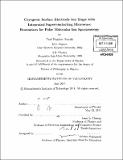Cryogenic surface electrode ion traps with integrated superconducting microwave resonators for polar molecular ion spectroscopy
Author(s)
Antohi, Paul Bogdan
DownloadFull printable version (18.88Mb)
Other Contributors
Massachusetts Institute of Technology. Dept. of Physics.
Advisor
Isaac L. Chuang.
Terms of use
Metadata
Show full item recordAbstract
Trapped cold molecules open the possibility of studying ultracold chemistry and astrophysical processes in laboratory settings. Their rich internal structure also makes them suitable for quantum information manipulation or for tests of fundamental laws of nature. These experiments require precise control over the molecular internal degrees of freedom. There are few present proposals for trapping and cooling molecules. One proposal is based on confining neutral polar molecules in DC Stark shift traps, but this approach presents some issues. An attractive alternative is to confine polar molecular ions in RF Paul ion traps, which is the focus of this thesis. The objectives here are to develop the theoretical models and to devise the experimental components and methods to investigate the coupling of polar molecular ions' rotational states to the microwave radiation. The new approach presented here is based on co-trapping Sr+ atomic ions together with SrCl+ molecular ions in a cryogenic surface electrode RF ion trap and on using the coupling of the molecular ion's rotational states to an integrated superconducting microwave line or cavity either as a cooling method or for precise rotational spectroscopy. The first part of the thesis describes two theoretical methods for observing the coupling of the microwave radiation to the rotational levels of a molecule. The first method proposed is based on the enhancement of the molecular rotational transition rates by the co-trapped molecular-atomic ions Coulomb collisions. The second method is based on microwave cavity assisted heating or cooling of the molecular ions. The second part of the thesis presents the development of a cryogenic surface electrode RF ion trap with an integrated microwave transmission line/resonator. The ion trap is operated in a 4.2 K closed cycle cryostat.
Description
Thesis (Ph. D.)--Massachusetts Institute of Technology, Dept. of Physics, 2011. Cataloged from PDF version of thesis. Includes bibliographical references (p. 129-144).
Date issued
2011Department
Massachusetts Institute of Technology. Department of PhysicsPublisher
Massachusetts Institute of Technology
Keywords
Physics.